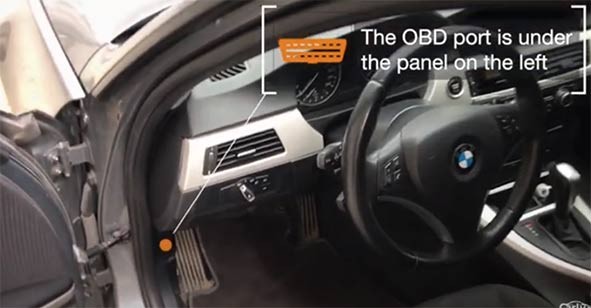The OBD2 port on your BMW X1 is a small yet powerful gateway to understanding your vehicle’s health and performance. This guide will show you where to find the OBD2 port on your X1 and how to use it with an OBD2 reader to unlock valuable information about your car. Understanding how to use this port can save you money on repairs and give you greater control over your X1’s maintenance.
What is the OBD2 Port and What Does it Do?
OBD stands for On-Board Diagnostics. The OBD2 port, also known as the diagnostic port, is a standardized 16-pin connector found in most vehicles manufactured after 1996. It allows you to connect a diagnostic tool, known as an OBD2 reader or scanner, to access your car’s computer system and retrieve valuable data. This data includes:
- Diagnostic Trouble Codes (DTCs): These codes indicate specific problems within your vehicle’s systems.
- Real-time Data: Monitor engine performance, sensor readings, and other crucial parameters in real-time.
- Freeze Frame Data: Capture a snapshot of the vehicle’s data at the moment a fault code was triggered.
Where is the OBD2 Port Located on a BMW X1?
The OBD2 port in a BMW X1 is typically located under the driver’s side dashboard, near the steering column. You may need to look up under the dash to find it. It’s a trapezoidal-shaped connector with a 16-pin configuration.
How to Use the BMW X1 OBD2 Port
Using the OBD2 port is simple:
- Locate the OBD2 port.
- Plug in your OBD2 reader. Ensure the reader is firmly connected.
- Turn on your vehicle’s ignition. You may not need to fully start the engine, but the ignition should be in the “on” position.
- Connect to the OBD2 reader. This process depends on the type of reader you’re using. Some readers connect directly to a smartphone or laptop via Bluetooth or Wi-Fi, while others may have a built-in display.
- Access and interpret the data. Use the accompanying software or app to read and understand the information provided by your OBD2 reader.
Benefits of Using an OBD2 Reader on Your BMW X1
- Diagnose Problems: Identify the root cause of warning lights or performance issues.
- Save Money on Repairs: Diagnose problems yourself and potentially avoid costly mechanic visits.
- Monitor Vehicle Health: Track your X1’s performance and catch potential issues early.
- Customize Your BMW: Some advanced OBD2 readers allow for coding changes to personalize your vehicle’s settings. (Consult your vehicle’s documentation before making any coding changes)
- Perform Maintenance: Reset service lights and perform other basic maintenance tasks.
Choosing the Right OBD2 Reader for Your BMW X1
Consider these factors when selecting an OBD2 reader:
- Compatibility: Ensure the reader is compatible with your BMW X1’s model year and your smartphone or computer.
- Functionality: Decide which features are important to you, such as basic diagnostics, real-time data, coding capabilities, and maintenance functions.
- Wireless Connectivity: Bluetooth or Wi-Fi connectivity offers greater convenience.
- Software and App Support: Choose a reader with user-friendly software and regular updates.
Conclusion
The OBD2 port is a valuable tool for any BMW X1 owner. By understanding its location and how to use it with an OBD2 reader, you can gain greater control over your vehicle’s maintenance, diagnose problems, and potentially save money on repairs. Select the right OBD2 reader for your needs and start unlocking the power of your X1’s diagnostic port.

